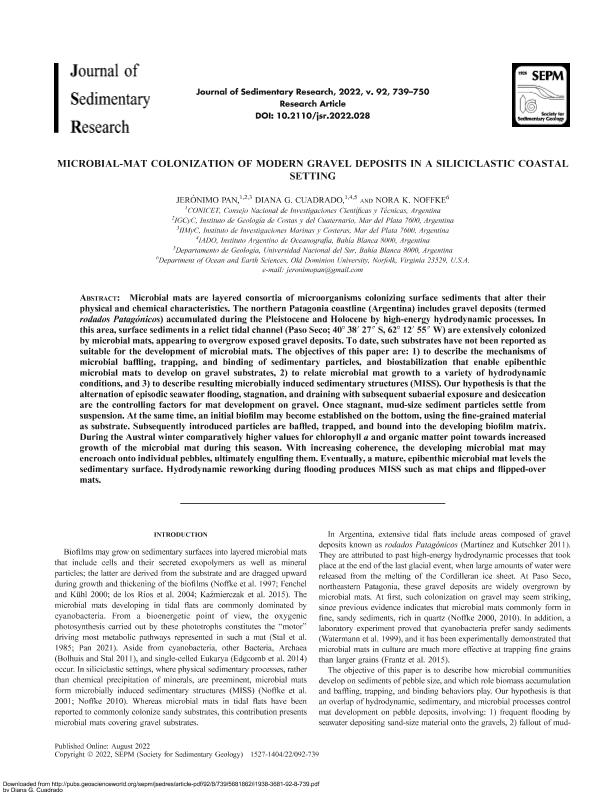Mostrar el registro sencillo del ítem
dc.contributor.author
Pan, Jeronimo

dc.contributor.author
Cuadrado, Diana Graciela

dc.contributor.author
Noffke, Nora K.
dc.date.available
2024-04-08T11:24:46Z
dc.date.issued
2022-08
dc.identifier.citation
Pan, Jeronimo; Cuadrado, Diana Graciela; Noffke, Nora K.; Microbial-mat colonization of modern gravel deposits in a siliciclastic coastal setting; Society for Sedimentary Geology; Journal of Sedimentary Research - (Print); 92; 8; 8-2022; 739-750
dc.identifier.issn
1527-1404
dc.identifier.uri
http://hdl.handle.net/11336/232261
dc.description.abstract
Microbial mats are layered consortia of microorganisms colonizing surface sediments that alter their physical and chemical characteristics. The northern Patagonia coastline (Argentina) includes gravel deposits (termed rodados Patagónicos) accumulated during the Pleistocene and Holocene by high-energy hydrodynamic processes. In this area, surface sediments in a relict tidal channel (Paso Seco; 40° 38′ 27″ S, 62° 12′ 55″ W) are extensively colonized by microbial mats, appearing to overgrow exposed gravel deposits. To date, such substrates have not been reported as suitable for the development of microbial mats. The objectives of this paper are: 1) to describe the mechanisms of microbial baffling, trapping, and binding of sedimentary particles, and biostabilization that enable epibenthic microbial mats to develop on gravel substrates, 2) to relate microbial mat growth to a variety of hydrodynamic conditions, and 3) to describe resulting microbially induced sedimentary structures (MISS). Our hypothesis is that the alternation of episodic seawater flooding, stagnation, and draining with subsequent subaerial exposure and desiccation are the controlling factors for mat development on gravel. Once stagnant, mud-size sediment particles settle from suspension. At the same time, an initial biofilm may become established on the bottom, using the fine-grained material as substrate. Subsequently introduced particles are baffled, trapped, and bound into the developing biofilm matrix. During the Austral winter comparatively higher values for chlorophyll a and organic matter point towards increased growth of the microbial mat during this season. With increasing coherence, the developing microbial mat may encroach onto individual pebbles, ultimately engulfing them. Eventually, a mature, epibenthic microbial mat levels the sedimentary surface. Hydrodynamic reworking during flooding produces MISS such as mat chips and flipped-over mats.
dc.format
application/pdf
dc.language.iso
eng
dc.publisher
Society for Sedimentary Geology

dc.rights
info:eu-repo/semantics/openAccess
dc.rights.uri
https://creativecommons.org/licenses/by-nc-sa/2.5/ar/
dc.subject
Microbial mats
dc.subject.classification
Otras Ciencias de la Tierra y relacionadas con el Medio Ambiente

dc.subject.classification
Ciencias de la Tierra y relacionadas con el Medio Ambiente

dc.subject.classification
CIENCIAS NATURALES Y EXACTAS

dc.title
Microbial-mat colonization of modern gravel deposits in a siliciclastic coastal setting
dc.type
info:eu-repo/semantics/article
dc.type
info:ar-repo/semantics/artículo
dc.type
info:eu-repo/semantics/publishedVersion
dc.date.updated
2024-04-03T13:37:51Z
dc.identifier.eissn
1938-3681
dc.journal.volume
92
dc.journal.number
8
dc.journal.pagination
739-750
dc.journal.pais
Estados Unidos

dc.journal.ciudad
Lawrence
dc.description.fil
Fil: Pan, Jeronimo. Consejo Nacional de Investigaciones Científicas y Técnicas. Centro Científico Tecnológico Conicet - Mar del Plata. Instituto de Investigaciones Marinas y Costeras. Universidad Nacional de Mar del Plata. Facultad de Ciencias Exactas y Naturales. Instituto de Investigaciones Marinas y Costeras; Argentina. Universidad Nacional de Mar del Plata. Facultad de Ciencias Exactas y Naturales. Instituto de Geología de Costas y del Cuaternario. Provincia de Buenos Aires. Gobernación. Comisión de Investigaciones Científicas. Instituto de Geología de Costas y del Cuaternario; Argentina
dc.description.fil
Fil: Cuadrado, Diana Graciela. Consejo Nacional de Investigaciones Científicas y Técnicas. Centro Científico Tecnológico Conicet - Bahía Blanca. Instituto Argentino de Oceanografía. Universidad Nacional del Sur. Instituto Argentino de Oceanografía; Argentina. Universidad Nacional del Sur. Departamento de Geología; Argentina
dc.description.fil
Fil: Noffke, Nora K.. Old Dominion University; Estados Unidos
dc.journal.title
Journal of Sedimentary Research - (Print)

dc.relation.alternativeid
info:eu-repo/semantics/altIdentifier/doi/http://dx.doi.org/10.2110/jsr.2022.028
dc.relation.alternativeid
info:eu-repo/semantics/altIdentifier/url/https://pubs.geoscienceworld.org/sepm/jsedres/article/92/8/739/616387/Microbial-mat-colonization-of-modern-gravel
Archivos asociados
